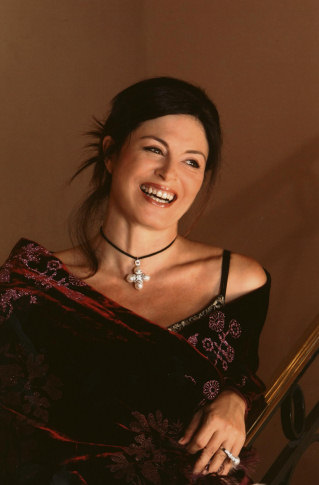Other Links
Editorial Board
-
Editor - Bill Kenny
-
Deputy Editor - Bob Briggs
Founder - Len Mullenger
Google Site Search
SEEN AND HEARD
INTERNATIONAL CONCERT REVIEW
Beethoven, Berlioz :
Anna-Caterina Antonacci, soprano, Rotterdam Philharmonic Orchestra ,
Yannick Nézet-Séguin (conductor) De Doelen Concert Hall, Rotterdam
8.2.2009 (BvW)
Beethoven:
Symphony no.1 in C, op.21 (1799/1800)
Berlioz:
La mort de Cléopâtre (1829) – cantata for soprano and orchestra
Berlioz: Symphonie fantastique, op.14 (1830)

After
a New Year’s concert with some very fine playing in Richard Strauss’ Don Juan
and the Rosenkavalier suite and real elegance and finesse in a few polkas
from Josef Strauss, Yannick Nézet-Séguin came back this week to Rotterdam with
a very ambitious program connecting two revolutionary minds: Beethoven and
Berlioz. This program was played on four consecutive days in Rotterdam, each
time sold out, in this way “serving” more than 8000 people. All concerts were
recorded for a later release on CD.
Yannick started with a very concentrated and interesting reading of Beethoven’s
First Symphony. No easy listening in his case but indeed a revolutionary
concept. The orchestra sounded open, transparent and the articulation was crisp
and clear. Tempi were near ideal but I would still call this “work in progress”.
Yannick (conducting from memory) was so busy putting his stamp on balance,
articulation and dynamics that the overall form of each movement was often lost
in details. This Beethoven reminded me (again) of Sir Simon Rattle’s Beethoven:
raw sometimes, (too) full of unexpected details and with extreme dynamics.
Yannick’s choice for loud trumpets and timpani (and in De Doelen that means
really loud) couldn’t convince me. The orchestra played very well (second
violins!) and with full concentration.
After this very intense Beethoven Berlioz’ cantata La Mort de Cléopâtre
(his third attempt for the Prix de Rome) brought an immensely satisfying
performance. As Cléopatra, Italian Anna-Caterina Antonacci brought all the
drama and changes of mood and colour one could wish for in this score. Her voice
certainly has to be heard live, that’s for sure, because her projection really
comes to the back of the hall, so well focused it is. At the same time her
“presence” and radiance are captivating. The audience was spellbound although
I’m sure most of the people didn’t follow the text… I never listened to
Anna-Caterina Antonacci in concert before but my goodness, this was an event!
The accompaniment of the orchestra was also very good, well prepared and very
attentive. Bravo!
After the break Berlioz’ Symphonie fantastique was played well, precisely
and often interestingly but I really missed what Leonard Bernstein used to call
“Berlioz taking a trip”. “This is the first psychedelic symphony in history”
said Bernstein: Berlioz wrote about a hero (himself) of a “morbidly sensitive
nature and poisoned with opium”. His beloved, haunts the whole piece as an idée
fixe. “Feelings, sensations and memories are translated by his sick brain into
musical thoughts and images” (Berlioz again). He dreams (fourth movement) that
he is a murderer and goes to the guillotine. In the fifth movement he is at his
own funeral: “a nightmare with witches on broomsticks, blood curling laughter of
demons and devils and grinning monsters.” (Bernstein) .
And Bernstein adds in his illuminating explanation on CD (after his
interpretation of the symphony): “You can become a nervous wrack playing this
symphony because it is a portrait of a nervous wrack. It comes close to the
borderline of insanity”>
Listening this afternoon I would never ever have thought of such a program! This
reading was never scary, nor mad, there were no hallucinations and certainly no
sense of evil. It was a virtuoso performance but nothing more. Yannick was
smiling, enthusiastic and very happy at the end. The waltz was elegant with
Yannick as a maître de ballet, the march to the scaffold was, well, the
kind of scariness in a Disney-movie. It was like reading about a nightmare
instead of having one.
Here, memories of Valeri Gergiev came to mind: I remember his
Fantastique very well. It was certainly not played very well (no rehearsal
time) but it did send shivers down the spine. Not, of course that I want
Yannick to become a nervous wreck, but in this case he was clearly conducting a
good performance without taking Berlioz’ intentions literally. This distancing
maybe more mentally healthy but at the end, I would have liked him
to take the risk and jump - maybe by visiting one of our famous Dutch
“coffeeshops” to prepare himself before the concert …
Yannick Nézet-Séguin is back in March with Schubert’s Ninth Symphony and
Mozart’s Piano concerto no.24 with Stephen Bishop.
Bas van Westerop
Back
to Top
Cumulative Index Page
